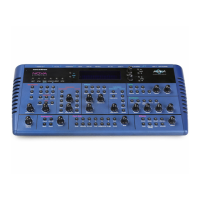ARPEGGIATOR SECTION
Page 5 looks like so:
As can be seen the higher parameter is “Fill-in”, in this case with a value of On - Played.
This parameter applies only to MONOPHONIC patterns, it has no affect on polyphonic patterns. Use the higher fast data knob to
adjust the value. In fact, this parameter can be thought of as two different parameters combined. The first Part (always “On” or
“Off”) determines how the Arpeggiator behaves when you play more or less notes than the Arpeggiator pattern was written to cope
with.
When this Part of the parameter is set to “Off”, if you play less notes than the pattern is expecting, the highest note you have
played will be used for all the notes in the pattern data which are greater than your highest played note. If however, you have
played more notes than the pattern was written to cope with, then played notes which are higher than the highest note in the pat-
tern data are never sounded. When this Part of the parameter is set to “On”, if you play less notes than the pattern is expecting,
your played notes will be used intelligently for all the notes in the pattern data which are greater than your highest played note. If
however, you have played more notes than the pattern was written to cope with, then played notes which are higher than the high-
est note in the pattern data are used, replacing their corresponding lower notes, every other time the pattern cycles around.
Perhaps the best way to understand how this works is by experimentation - altering the values & number of notes played while a
mono arpeggiation is running. The second Part of the parameter (“Up”, “Down” or “Played”) determines which note ordering system
is used for the monophonic pattern. When set to “Up”, note 1 in the pattern data will refer to the lowest note played, note 2 the next
note up & so on. When set to “Down”, note 1 in the pattern data will refer to the highest note played, note 2 the next note down &
so on. When set to “Played”, note 1 in the pattern data will refer to the earliest note played, note 2 the next note to be played & so
on. By adjusting this value, you can in effect, treble the number of available monophonic patterns you have access to !
The most musical settings for this parameter are any of the “On” options. The range of this parameter is Off - Up, On - Up, Off -
Down, On - Down, Off - Played & On - Played. This parameter is memorised with a Program.
When the Arpeggiator is using one of the standard Up / Down patterns ( Mono patterns 000 to 003 ), Fill-in can be used to deter-
mine how the pattern sweeps through the number of octaves set on page 4 of the Arpeggiator Menu. When the Fill-in parameter is
set to any of the "On" settings, the pattern will sweep through all of the available in octaves in a single pass of the pattern. When
the Fill-in parameter is set to any of the "Off" settings, the pattern will use each octave in turn for a single pass of the pattern.
When using these patterns, previous OS Versions always behaved as if Fill-in was set to "Off".
The Note Ordering part of the Fill-in parameter is ignored by Mono Patterns 000 to 010 which generate arpeggios by algorithms
rather than fixed pattern data.
As can be seen the Lower parameter is “Sync”. In this case with a value of 16ths
This parameter determines the time signature at which the Arpeggiator runs from the Internal or External MIDI Clock.
Use the lower Fast Data knob to adjust the value of this parameter. The range of this parameter is 32nd Triplet, 32nd, 16th Triplet,
16th, 8th Triplet, 16th Dotted, 8th, 4th Triplet, 8th Dotted, 4th, 2nd Triplet, 4th Dotted, 2nd, 1 Bar Triplet, 2nd Dotted, 1 Bar, 2 Bar
Triplet, 1 Bar Dotted, 2 Bars, 4 Bar Triplet, 3 Bars, 5 Bar Triplet, 4 Bars, 3 Bar Dotted ( 4.5 Bars ), 7 Bar Triplet, 5 Bars, 8 Bar
Triplet, 6 Bars, 7 Bars, 5 Bar Dotted ( 7.5 Bars ), 8 Bars, 6 Bar Dotted ( 9 Bars ), 7 Bar Dotted ( 10.5 bars ) & 8 Bar Dotted ( 12
Bars ). This parameter is memorised with a Program.
There is a conversion chart on page 131 giving specific MIDI tick values for each of the options of this parameter.

